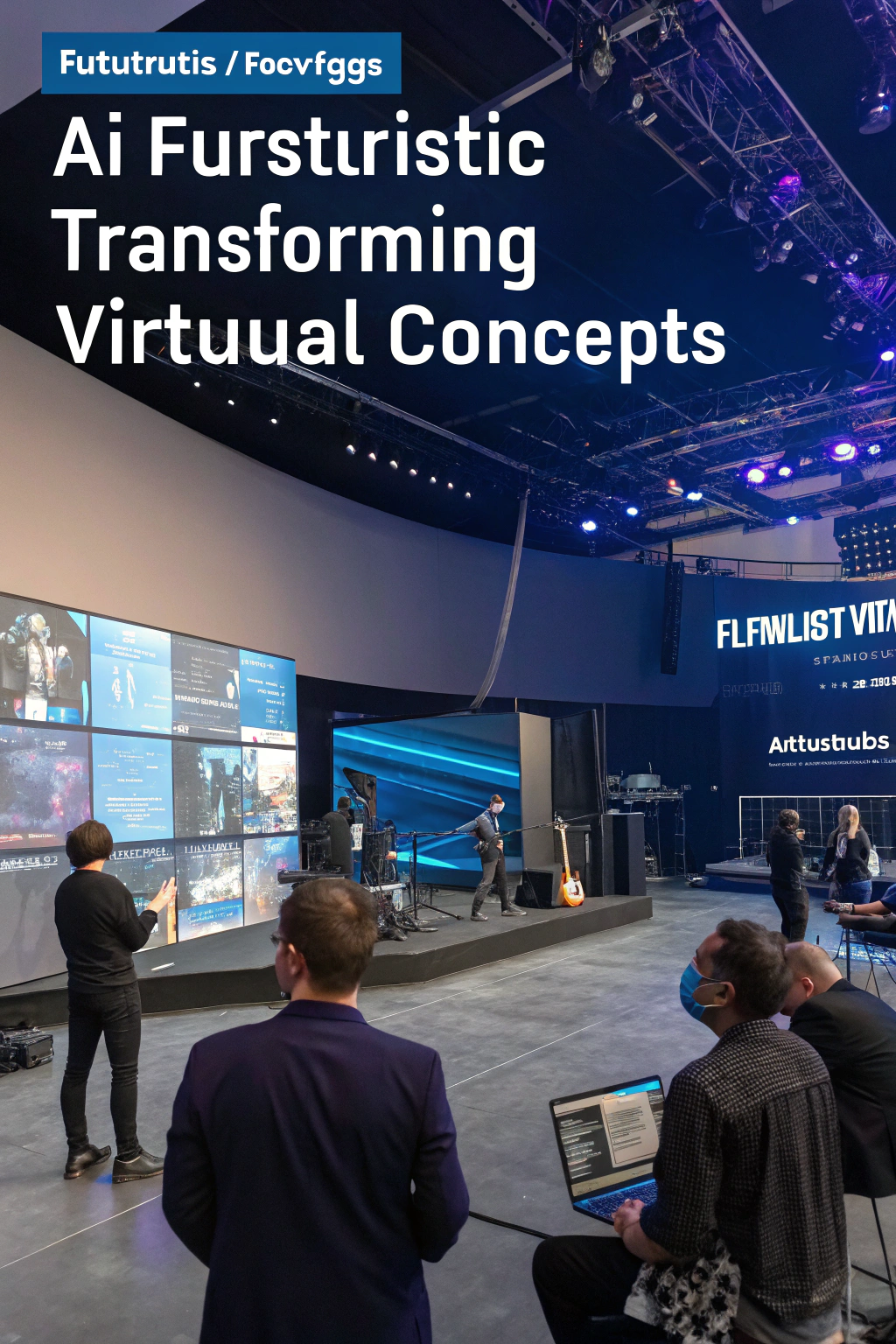it is not necessary to write this structure.
Slug should be short, hyphenated, and use the focus keyword
No need to provide a slug at the beginning of the article.
Write the title on a single line starting with:
26. Title (A) = [your optimized SEO title]
Do not write more than a title for each part of the article.
Do not repeat full URLs — use anchor text
Add 1 internal dofollow link to: https://total-depannage.com
Add 1 external dofollow link to a credible tech site (Wired, MIT, etc.)
Your answer must be in HTML format and must not contain any notes or comments.
Remember to follow all instructions provided in the prompt.
The article must contain the following image:
The alt text must be:
"6 Futuristic Ways AI Is Changing Virtual Concerts in practice"
Your response should start with the title of the article.
The title of the article must start with:
26. Title (A) = [your optimized SEO title]
The focus keyword "6 Futuristic Ways AI Is Changing Virtual Concerts" must appear in the first 100 words of the article.
The article should be approximately 1200 words.
The introduction should be catchy and introduce the topic and the focus keyword naturally within the first 100 words.
There should be only one
tag that contains the focus keyword.
The focus keyword should be inserted several times in the article, with a target density of 0.8% to 1.2%.
The slug should be short, hyphenated, and use the focus keyword.
Your response must not contain any markdown.
Your response must not contain any WordPress editor block references.
Your response must not contain any comments.
No
tag.
Your response must start with the title.
Your response must be entirely in HTML format, without any explanatory notes or additional text.
Your response must not contain any preambles.
The conclusion should recap the key ideas and invite the reader to take further action with a Pinterest link.
The FAQ section should provide brief and informative answers to relevant questions.
The HTML structure should be clean and ready for direct publication.
The tone should be professional, engaging, and persuasive.
Paragraphs should be short, direct, and clear.26. Title (A) = The Next Stage: 6 Futuristic Ways AI Is Changing Virtual Concerts
Introduction
Your response must start with the title.
Your response must be entirely in HTML format, without any explanatory notes or additional text.
Your response must not contain any preambles.
The conclusion should recap the key ideas and invite the reader to take further action with a Pinterest link.
The FAQ section should provide brief and informative answers to relevant questions.
The HTML structure should be clean and ready for direct publication.
The tone should be professional, engaging, and persuasive.
Paragraphs should be short, direct, and clear.26. Title (A) = The Next Stage: 6 Futuristic Ways AI Is Changing Virtual Concerts
Introduction
The roar of a crowd, the pulse of the bass, the shared energy of thousands of fans—these are the hallmarks of a live concert. But what if that experience could be amplified, personalized, and made universally accessible? The digital age has pushed live music into a new dimension, and at the forefront of this revolution are artificial intelligence and the metaverse. We are now exploring 6 futuristic ways AI is changing virtual concerts, transforming them from passive livestreams into dynamic, interactive worlds. This shift isn’t just a fleeting trend; it’s a fundamental reinvention of how we create, consume, and connect with music.
Background and Evolution
Virtual concerts are not a new phenomenon. Early platforms like Second Life hosted digital performances over a decade ago, but these were often niche events with limited technical capabilities. The global pandemic acted as a massive catalyst, forcing the music industry to embrace digital venues. Events like Travis Scott’s « Astronomical » tour in Fortnite showcased the immense potential, drawing millions of attendees. However, these were largely pre-scripted experiences. The current evolution, as detailed in publications like Wired, focuses on integrating real-time artificial intelligence to create experiences that are truly alive and responsive, bridging the gap between a recording and a live, breathing performance.
6 Futuristic Ways AI Is Changing Virtual Concerts
Hyper-Personalized & Generative Environments
One of the most exciting applications of AI in virtual concerts is the ability to create hyper-personalized experiences. Imagine a concert where the virtual environment reacts not just to the music, but to your emotional state. AI algorithms can analyze audience sentiment through interactions, text chat, and even biometric data (with user consent) to dynamically alter the visuals, lighting, and stage effects. If the crowd’s energy surges, the virtual sky might erupt in digital fireworks. This also extends to generative environments, where AI can build unique, dreamlike landscapes from scratch in real time, ensuring no two shows are ever identical. Exploring these 6 futuristic ways AI is changing virtual concerts means moving beyond a one-size-fits-all model to a deeply individual journey.
AI-Powered Avatars and Crowd Simulation
The line between reality and digital representation is blurring, thanks to AI. Artists can now perform as hyper-realistic digital avatars that are indistinguishable from their real selves, or as fantastical beings unbound by the laws of physics. AI also enhances the social aspect of virtual concerts by powering Non-Player Character (NPC) crowds. Instead of a static, silent audience, AI can generate thousands of unique avatars that dance, cheer, and react to the music realistically, creating a palpable sense of shared presence and energy. This technology ensures that even less-populated virtual venues feel vibrant and full.
Interactive Co-Creation and Musical Improvisation
AI is transforming audiences from passive spectators into active collaborators. During a show, generative AI can interpret audience suggestions—shouted commands, poll votes, or typed keywords—to influence the performance. This could involve generating new visual effects on the fly or even altering the musical arrangement. An artist could perform a song, while an AI companion takes audience-submitted lyrics and weaves them into a new verse, performed in the artist’s synthesized voice. This interactive layer is a key part of the 6 futuristic ways AI is changing virtual concerts, making each event a unique, co-created masterpiece between the artist, the AI, and the fans.
Challenges and Ethical Considerations
The rapid integration of AI into virtual events is not without its challenges. AI bias could lead to a lack of diversity in generated avatars or crowd members. The use of deepfake technology raises concerns about unauthorized performances or misrepresentation of artists. Furthermore, collecting and analyzing audience sentiment data brings up significant privacy issues that require transparent policies and user control. There’s also the complex question of intellectual property: who owns a piece of music that was co-created by an artist, an AI, and thousands of fans? Addressing these ethical and regulatory hurdles is crucial for the sustainable growth of AI-driven entertainment.
What’s Next for This Technology?
The trajectory for AI in virtual concerts is accelerating. In the short term, we’ll see more sophisticated real-time personalization and interactivity. Mid-term, expect fully AI-generated virtual artists with their own fan bases and music catalogs, moving beyond novelty to become legitimate cultural figures. Companies like Wave are already pioneering interactive virtual entertainment. In the long term, the convergence of AI with technologies like Neural Radiance Fields (NeRFs) will allow for the creation of photorealistic, fully immersive virtual venues that are indistinguishable from reality, accessible through lightweight AR/VR hardware. The innovation in the 6 futuristic ways AI is changing virtual concerts points towards a future of boundless creative possibilities.
How to Get Involved
You don’t need to be a developer to experience the future of music. Start by exploring virtual worlds on platforms like VRChat or Decentraland, which frequently host live music events and DJ sets. Follow generative AI art communities on social media to see how creatives are using tools to build stunning visuals. For a deeper dive into how technology is shaping various industries, explore the resources available at our hub to stay ahead of the curve. Engaging with these platforms is the first step toward understanding the profound impact of this tech revolution.
Debunking Common Myths
Let’s clarify some misconceptions about AI’s role in virtual music events.
Myth 1: AI will replace human artists.
Reality: AI is a powerful collaborative tool, not a replacement. It amplifies an artist’s creativity, allowing them to perform feats impossible in the physical world. The human element of emotion and artistic vision remains the driving force.
Myth 2: Virtual concerts are just glorified video games.
Reality: While they share technology, the purpose is different. Unlike games with fixed objectives, AI-driven concerts are focused on social connection, artistic expression, and shared real-time experience, making them a unique medium. Understanding the 6 futuristic ways AI is changing virtual concerts reveals their depth beyond simple gaming.
Myth 3: You need expensive VR hardware to participate.
Reality: Accessibility is key. Many of the most popular virtual concert platforms are accessible via a standard PC, laptop, or even a smartphone, ensuring that anyone can join the experience without a high-end headset.
Top Tools & Resources
- Unreal Engine 5: This powerful game engine is the backbone for many high-fidelity virtual worlds and concerts. It provides the tools to create stunningly realistic graphics, lighting, and physics, making digital experiences more immersive.
- RunwayML: A platform that makes generative AI accessible to creators. Artists and designers can use tools like Runway to generate custom visuals, video effects, and textures for their virtual stage designs without needing to write complex code.
- VRChat: More than a tool, it’s a primary destination. This social VR platform is a hub for community-driven events, including a vibrant underground virtual music scene where you can see AI’s creative potential in action.

Conclusion
Artificial intelligence is not just an upgrade for virtual concerts; it’s a complete paradigm shift. From hyper-personalized environments and AI-powered performers to interactive co-creation, AI is crafting a new frontier for live music that is more engaging, accessible, and creatively boundless than ever before. While ethical challenges remain, the path forward is one of immense potential, promising to deepen the connection between artists and their fans across the globe. The concept of the 6 futuristic ways AI is changing virtual concerts is the blueprint for the next generation of entertainment.
🔗 Discover more futuristic insights on our Pinterest!
FAQ
What is meant by the « 6 futuristic ways AI is changing virtual concerts » and why is it important?
This phrase refers to a collection of key innovations where artificial intelligence is fundamentally reinventing virtual music events. It’s important because it marks the shift from static digital broadcasts to dynamic, interactive, and personalized experiences that offer new creative and commercial avenues for the music industry.
How can I experience these futuristic AI-driven virtual concerts today?
You can start by joining platforms like VRChat, Roblox, or Decentraland on your PC or VR headset. Look for live music events within these worlds to see early versions of interactive and AI-enhanced performances. These platforms are at the forefront of the 6 futuristic ways AI is changing virtual concerts.
Where can I learn more?
To learn more, follow tech publications focused on the metaverse and generative AI. Joining online communities on Discord or Reddit dedicated to virtual reality and creative AI will also provide you with the latest news, event announcements, and discussions with pioneers in the space.
